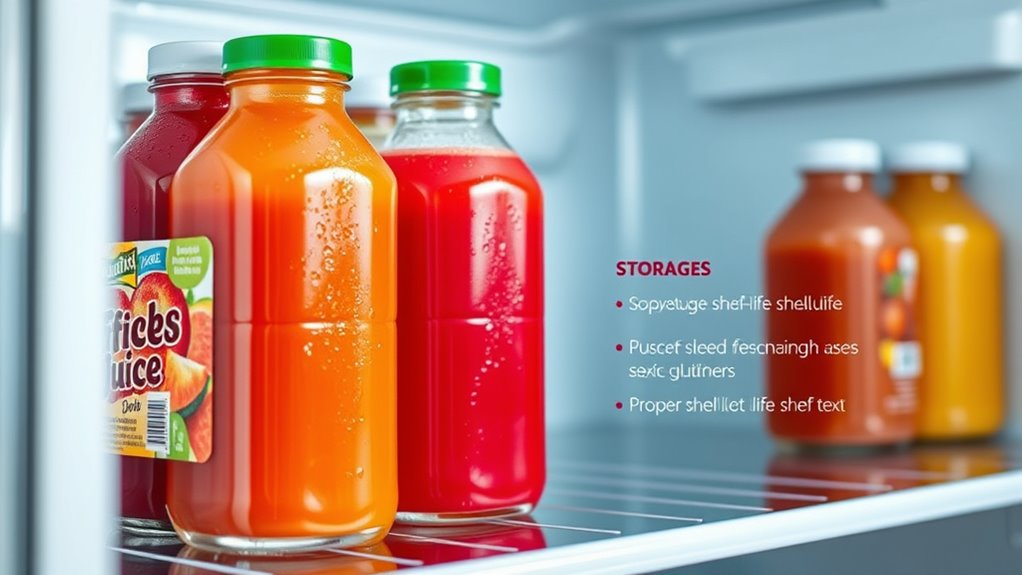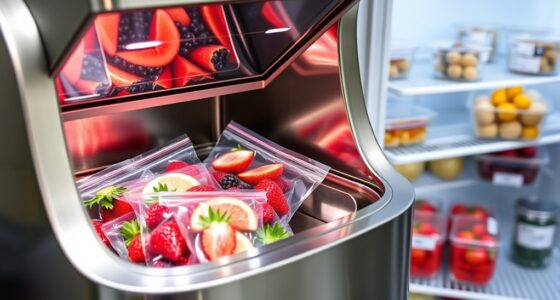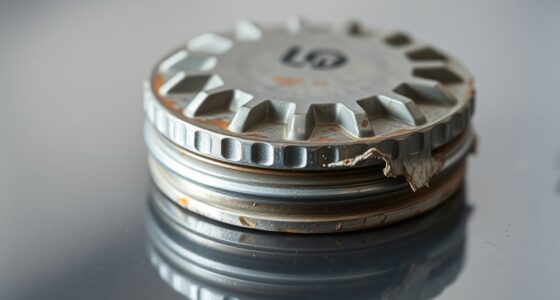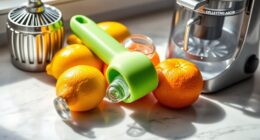To keep unpasteurized juices fresh and safe, store them in the fridge at 32–40°F in airtight containers that block light and air exposure. Use clean utensils when serving, and regularly check for spoilage signs like cloudiness or off odors. Consume within the recommended time frame, and consider freezing leftovers for longer storage. Purchasing from reputable sources and maintaining proper handling will help preserve quality—continue here to learn more tips.
Key Takeaways
- Store unpasteurized juices at 32–40°F (0–4°C) in airtight, opaque containers to prevent spoilage and oxidation.
- Regularly inspect for signs of spoilage such as cloudiness, mold, or sour odors, and discard if detected.
- Consume within 24–48 hours for optimal freshness and nutrient retention; label containers with dates.
- Purchase from reputable vendors who follow safety standards and ensure proper handling and storage.
- Use clean utensils and avoid cross-contamination by storing raw foods separately from unpasteurized juices.
Keep Juices Refrigerated at the Correct Temperature
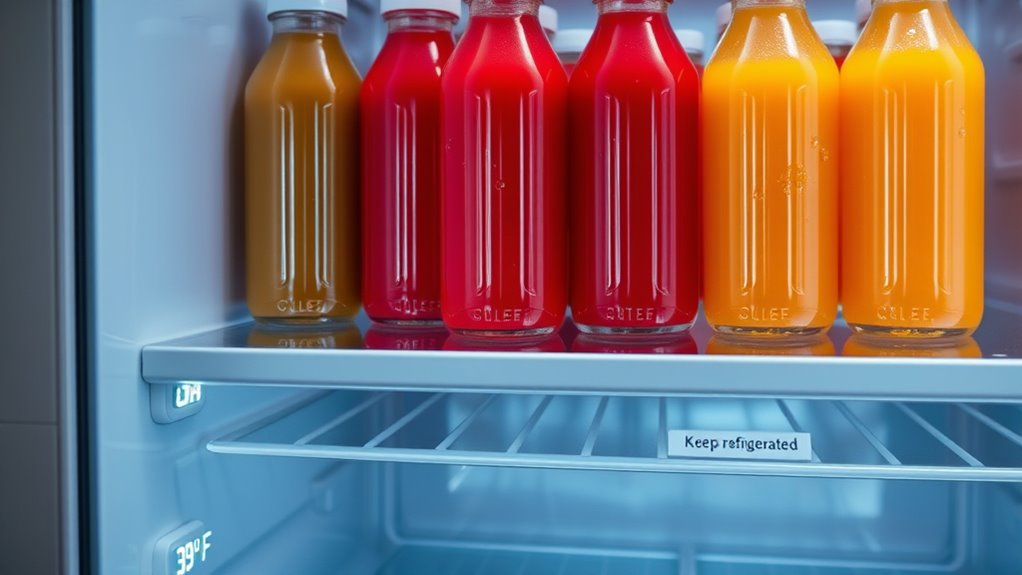
To guarantee your unpasteurized juices stay fresh longer and reduce the risk of spoilage, it’s vital to keep them refrigerated at the right temperature. Regular temperature monitoring helps ensure your fridge stays between 35°F and 40°F, the ideal range for preserving juice quality. Proper refrigeration maintenance is essential; clean your refrigerator regularly and check the thermostat for accuracy. Avoid leaving juices out at room temperature for extended periods, as this accelerates spoilage. Use a thermometer to verify the temperature consistently, especially if your fridge has a digital display. Keeping your juices at a stable, proper temperature inhibits bacterial growth and maintains their flavor and nutrients, ultimately extending their shelf life. Proper maintenance of your refrigerator is crucial for consistent temperature control and overall appliance performance. Prioritizing temperature control is key to safe, fresh unpasteurized juice. Additionally, AI-powered devices can assist in monitoring your refrigerator’s temperature more accurately and alert you to any deviations in real-time. Implementing smart home technology can further optimize your refrigeration management and ensure consistent storage conditions. Regularly checking for temperature fluctuations helps prevent unintended thawing or freezing that can compromise juice quality.
Use Airtight Containers to Preserve Freshness
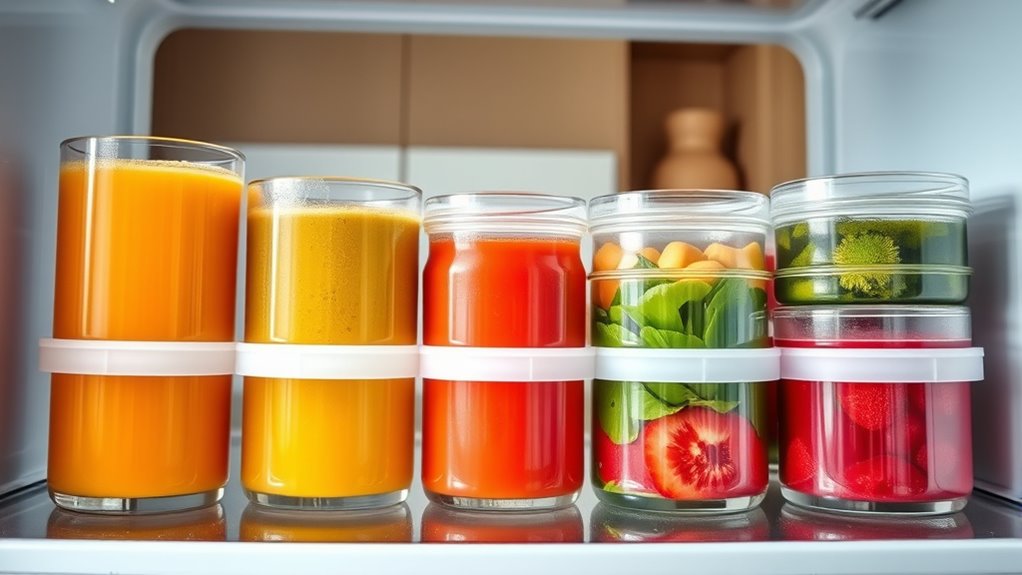
Using airtight containers is one of the most effective ways to keep your unpasteurized juices fresh. These containers prevent air from entering, which slows oxidation and spoilage. Choose high-quality airtight containers with secure seals to maximize freshness. For added protection, consider vacuum sealing your juice bottles or containers; this process removes excess air and creates an environment that inhibits bacteria growth. Vacuum sealing is especially useful if you’re storing large quantities or want to extend shelf life. Make sure containers are clean and dry before filling to prevent contamination. Properly sealed, airtight containers preserve flavor, aroma, and nutritional value longer than loosely covered options. Incorporating proper storage techniques and understanding oxygen exposure are crucial for maintaining juice quality over time. Additionally, understanding how factors influencing spoilage impact juice longevity can help tailor your storage practices for optimal freshness. Adopting storage best practices can further enhance the preservation process and ensure your juice stays fresh longer, especially by minimizing exposure to air.
Limit Exposure to Light and Air
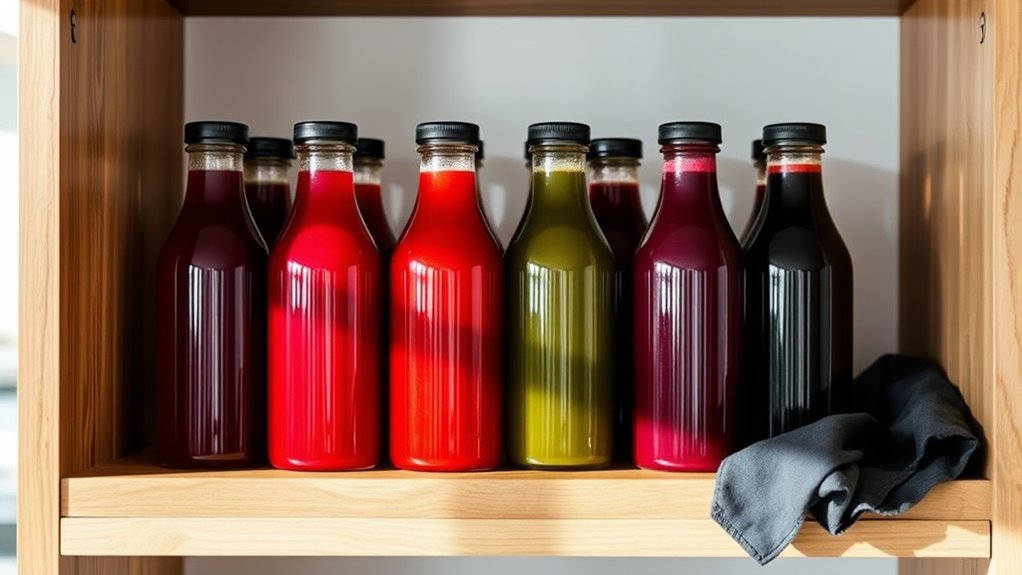
Limiting exposure to light and air is essential for maintaining the quality of your unpasteurized juices. Light exposure can cause oxidation, degrading nutrients and altering flavor, so store your juices in opaque containers or in a dark place. Air contact accelerates spoilage by promoting bacterial growth and oxidation, so keep the containers sealed tightly. Minimize the time your juice spends exposed to air during pouring or serving. Using airtight bottles not only prevents air contact but also preserves freshness longer. Avoid leaving your juice in direct sunlight or bright environments, as exposure to light speeds up deterioration. Proper storage techniques, including selecting the right essential oils for deep frying, can also contribute to better preservation of many food products. Additionally, understanding pinball machine weight can be useful when setting up storage spaces for larger containers. For added protection, consider incorporating protective styling benefits like crochet covers to shield your juice from light if stored in open areas. Employing proper storage containers designed for food preservation can further extend the shelf life of your juices. By controlling light and air exposure, you can extend the shelf life and keep your unpasteurized juices tasting fresh and nutritious.
Consume Juices Within the Recommended Time Frame
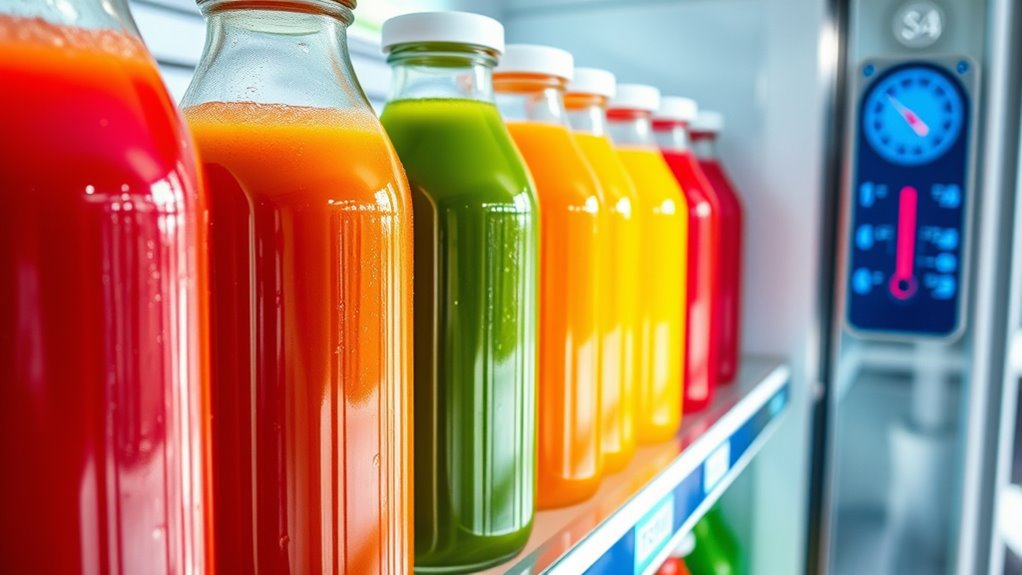
Consuming your unpasteurized juices within the recommended time frame guarantees you enjoy their best flavor and nutritional benefits. Fresh juices are most vibrant and nutrient-rich when consumed promptly, as extended storage can lead to nutrient degradation and flavor loss. By sticking to the suggested timeframe, you preserve the juice’s natural taste and ensure you receive maximum health benefits. Over time, enzymes and vitamins break down, diminishing both nutritional value and flavor quality. Proper storage conditions, such as maintaining a consistent cold temperature, can also extend the shelf life of your juices. Regularly checking storage dates and consuming juices before they expire helps you avoid waste and enjoy the freshest, most nutritious sip possible. Ensuring your storage environment stays consistently cold can significantly impact juice freshness and prevent spoilage. Additionally, understanding storage guidelines for different juice types can further prevent spoilage. Implementing proper hygiene practices during preparation and storage further reduces the risk of contamination. Remember, timely consumption is key to savoring the true essence of your unpasteurized juices while maximizing their healthful properties.
Avoid Cross-Contamination During Storage
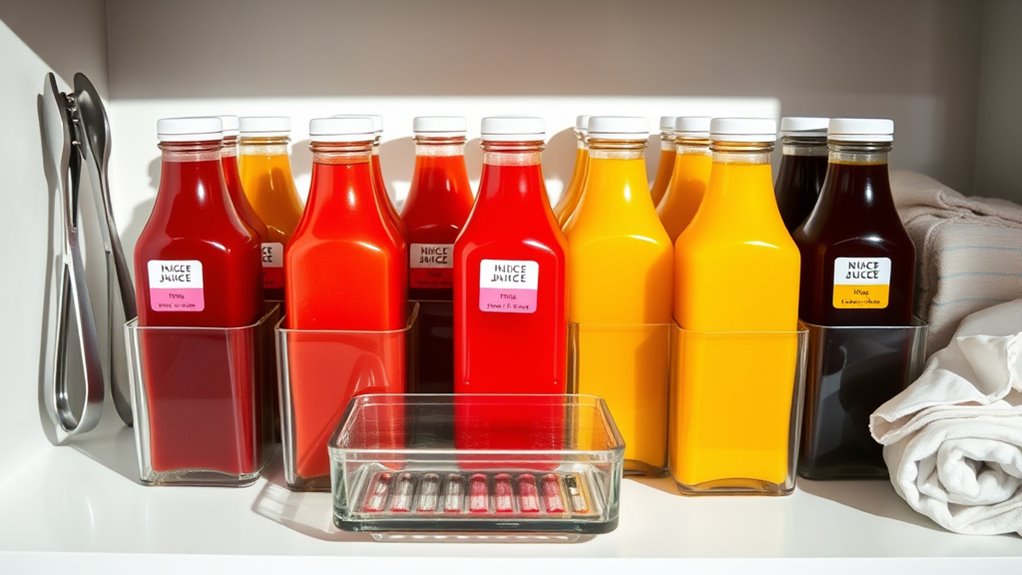
To prevent cross-contamination during storage, it’s essential to keep unpasteurized juices separate from other foods, especially raw meats, seafood, and unwashed produce. Use proper container sealing to guarantee juices don’t leak or spill, which helps maintain food safety practices. Always store juices in airtight containers that are clearly labeled to avoid mix-ups. Place them on the refrigerator’s top shelf away from raw meats and seafood to reduce the risk of drips or contact. Avoid overcrowding the fridge, which can promote contamination. Regularly clean your storage area and containers to prevent bacteria buildup. Additionally, understanding proper tuning techniques can help maintain the quality and safety of your stored juices. Proper temperature control is also crucial in preventing bacterial growth. Maintaining proper storage practices ensures the freshness and safety of your juices over time. Implementing sensor technology can help monitor temperature and humidity levels, further enhancing storage safety. By following these steps, you protect yourself and others from potential foodborne illnesses while extending the shelf life of your unpasteurized juices.
Check for Signs of Spoilage Regularly
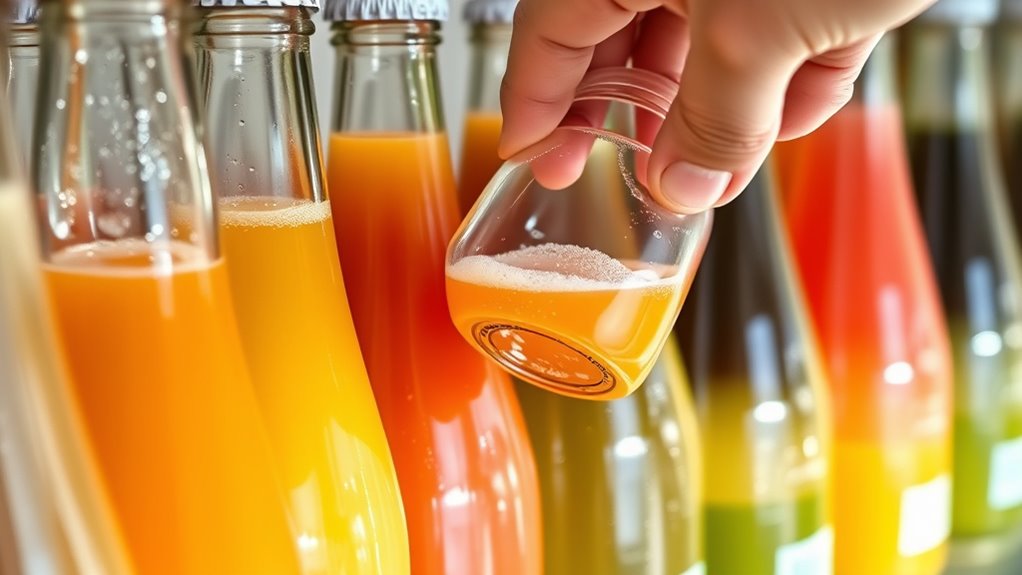
Since spoilage can occur quickly with unpasteurized juices, it’s important to check for signs regularly. Start by inspecting the visual cues—look for any cloudiness, sediment, or mold that wasn’t there before. If the juice develops a slimy texture or changes color, these are clear warnings. Odor changes are also key indicators; a sour, off, or fermented smell suggests fermentation or spoilage. Trust your senses—if anything seems unusual, it’s safer to discard the juice. Regularly monitoring helps prevent consuming spoiled products, which can cause illness. Keep a close eye on the appearance and smell of your unpasteurized juice, especially if it’s been stored for several days. Quick detection ensures you enjoy fresh, safe juice every time.
Use Clean Utensils When Serving

Always sanitize your serving utensils to prevent bacteria transfer. Using dirty tools can lead to cross-contamination and spoilage. Make sure to store your juices in proper containers to keep them fresh and safe.
Sanitize Serving Tools
Using clean utensils when serving unpasteurized juice is essential to prevent contamination and extend its shelf life. Before serving, verify your utensils and serving tools are thoroughly sanitized. Start by cleaning sponges and wiping down countertops with a food-safe sanitizer to eliminate bacteria. Regularly disinfect cutting boards and serving spoons, especially if they’ve come into contact with other foods. Avoid cross-contamination by never using the same utensils for different batches without washing them first. Keep a supply of sanitized utensils readily available to minimize handling. When serving, use clean tongs or ladles to prevent introducing bacteria. Properly sanitized tools help maintain the juice’s freshness and reduce the risk of spoilage, ensuring your juice stays safe and flavorful for longer.
Avoid Cross-Contamination Risks
To prevent cross-contamination, it is crucial to use clean utensils each time you serve unpasteurized juice. Follow strict cleaning protocols to guarantee no bacteria transfer between servings. Always wash utensils thoroughly between uses, especially if they’ve touched other surfaces or ingredients. Keep serving tools in designated storage zones to minimize contamination risk. Avoid placing utensils on contaminated surfaces, and store them separately from raw or spoiled items. Implementing clear procedures for cleaning and storing utensils helps maintain hygiene and reduces the chance of bacterial spread. Remember, even a small lapse can compromise the safety of your juice. Consistent attention to cleaning protocols and proper storage zones ensures your unpasteurized juice remains safe for consumption and extends its shelf life.
Use Proper Storage Containers
Choosing the right storage containers plays a key role in maintaining the safety and freshness of your unpasteurized juice. Use glass containers or clean plastic bottles with tight-fitting lids to prevent contamination and spoilage. These containers help preserve flavor and inhibit bacterial growth. Always wash containers thoroughly before filling, and avoid reusing containers that previously held other substances. When serving, use clean utensils and avoid touching the juice directly to prevent introducing bacteria. Proper storage minimizes oxidation, extending shelf life. Consider labeling containers with the date to monitor freshness. Using the right containers and utensils ensures your juice stays safe and delicious longer.
| Container Type | Benefits |
|---|---|
| Glass Containers | Non-reactive, easy to clean |
| Plastic Bottles | Lightweight, convenient, airtight |
| Reusable Jars | Durable, versatile |
| Single-use Bottles | Prevent cross-contamination, disposable |
| Storage Tips | Keep refrigerated, avoid direct sunlight |
Freeze Excess Juice for Extended Storage
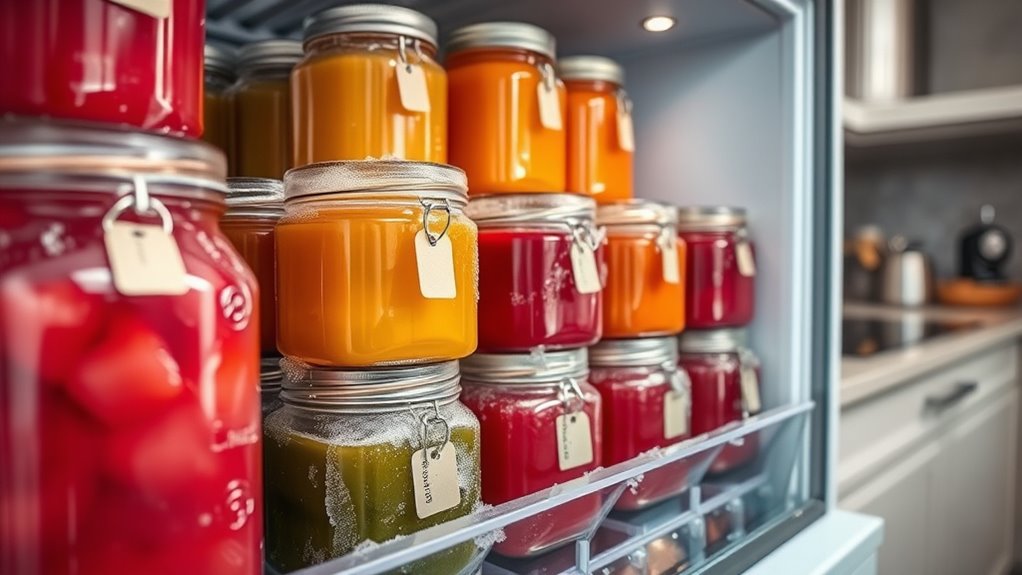
When freezing excess juice, use airtight containers to prevent freezer burn. Be sure to label and date each container so you know how long it’s been stored. Proper thawing is key to maintaining quality—refrigerate the juice slowly before enjoying.
Use Airtight Containers
Using airtight containers is essential for preserving the quality of your unpasteurized juice when freezing excess portions. Proper containers prevent air from reaching the juice, which helps maintain freshness preservation and prevents freezer burn. Choose containers that are specifically designed for freezing and have secure lids to avoid leaks. Leave some headspace in each container to allow for expansion as the juice freezes. Avoid using regular plastic bottles or containers that aren’t airtight, as they can compromise flavor and texture. Using the right containers ensures your juice stays fresh longer and retains its nutritional value. Proper storage methods save you from waste and ensure you enjoy high-quality juice whenever you want.
- Use containers with tight-fitting lids
- Opt for freezer-safe, BPA-free options
- Fill containers to just below the lid
- Avoid overfilling to prevent spills
- Label containers for easy identification
Label and Date
Labeling and dating your frozen juice containers helps you keep track of how long they’ve been stored. Clear, legible labels ensure you can quickly identify contents and avoid confusion. Use waterproof markers or pre-printed labels to maintain label clarity over time. Accurate dating is essential for monitoring freshness and preventing the accidental use of expired juice. Write the date when you freeze the juice, so you know exactly how long it’s been in storage. This helps you prioritize which containers to use first and reduces waste. Remember, consistent, precise labels make managing your frozen supply easier and safer. By maintaining good labeling practices, you ensure your unpasteurized juices stay fresh and are used within their optimal shelf life.
Thaw Properly
Proper thawing is essential to maintain the quality and safety of your unpasteurized juice. When you freeze excess juice, ensure you thaw it correctly to prevent bacteria growth and preserve flavor. Proper thawing involves gradual temperature changes, reducing the risk of spoilage. Always thaw juice in the refrigerator, not at room temperature, to ensure thaw safety. Avoid refreezing thawed juice, as it can compromise quality and safety. Use a clean container to prevent contamination during the process.
- Thaw in the refrigerator overnight
- Never thaw at room temperature
- Use a sealed container for thawing
- Check for signs of spoilage before use
- Consume within a few days after thawing
Purchase From Reputable Sources for Quality Assurance
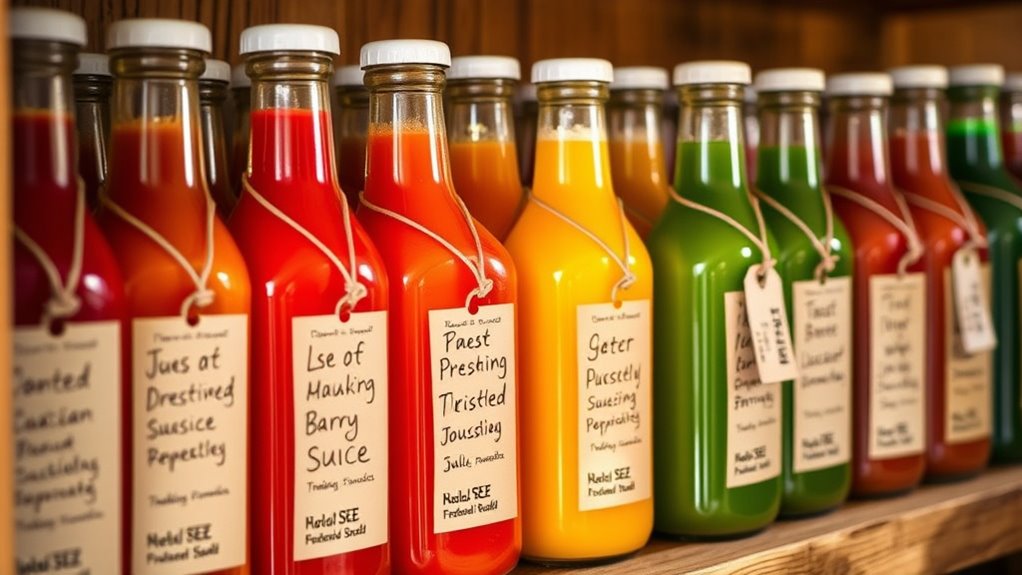
To guarantee you’re getting high-quality unpasteurized juice, it’s vital to buy from reputable sources. Look for suppliers with a strong reputation for freshness and safety. A reputable supplier will prioritize proper handling and storage, ensuring the juice remains fresh and safe to consume. Check for organic certification, which indicates the juice is produced without synthetic pesticides or additives, boosting its quality and purity. Additionally, researching a supplier’s reputation helps you avoid products that may be contaminated or compromised. Buying from trusted sources not only guarantees better flavor and nutritional value but also reduces the risk of foodborne illnesses. By choosing reputable vendors, you ensure your unpasteurized juice maintains its shelf life and health benefits.
Frequently Asked Questions
How Can I Tell if Unpasteurized Juice Has Gone Bad?
When checking if unpasteurized juice has gone bad, you should look for color change and fermentation signs. If the juice develops an unusual color or becomes cloudy, it’s a red flag. Also, watch for bubbles, fizz, or a sour smell—these indicate fermentation. Trust your senses: if it smells off or tastes strange, it’s safest to discard it. Always prioritize safety to avoid potential health risks.
Are There Specific Containers Best Suited for Storing Unpasteurized Juice?
Sure, because storing unpasteurized juice in a cardboard box is totally foolproof. Honestly, your best bets are glass containers or stainless steel bottles—they don’t react with the juice and keep it fresh longer. Glass is non-porous and easy to clean, while stainless steel is durable and maintains temperature. Avoid plastic, which can absorb flavors and harbor bacteria. Choose wisely, and your juice stays delicious and safe!
Can Adding Preservatives Extend the Shelf Life of Unpasteurized Juices?
Adding preservatives can improve preservative effectiveness, but it’s essential to contemplate natural preservative options to maintain juice quality. While preservatives might extend shelf life, natural choices like lemon juice or certain herbs can also help inhibit bacterial growth without compromising safety. You should weigh the benefits of preservatives against potential flavor changes or safety concerns, focusing on natural options for a healthier, longer-lasting product.
How Does Temperature Fluctuation Affect Juice Spoilage?
Temperature fluctuation can considerably impact juice spoilage by causing inconsistent refrigeration. When temperatures vary, bacteria and mold thrive, speeding up spoilage. You should maintain temperature consistency in your refrigeration to slow down this process. Timely refrigeration also ensures your juice stays fresh longer. Avoid frequent opening and closing of the fridge, and keep the temperature steady. Proper refrigeration timing is essential to preserve flavor and safety, preventing early spoilage.
Is It Safe to Reuse Plastic Bottles for Storing Unpasteurized Juice?
Reusing plastic bottles for unpasteurized juice isn’t always safe. You need to take into account plastic bottle hygiene and bottle material safety. Over time, bottles may harbor bacteria or degrade, especially if not properly cleaned. Always wash thoroughly with hot, soapy water and ensure the plastic is food-grade. If the bottle shows cracks or clouding, it’s best to discard it. Using safe, clean bottles helps prevent contamination and keeps your juice fresh.
Conclusion
Now that you know these shelf-life tips, you’re all set to keep your unpasteurized juices fresh and safe. But beware—sometimes, even the tiniest sign of spoilage can hide surprises. Will you catch it in time? Staying vigilant is key. Keep your juice properly stored, check regularly, and trust your senses. With a little care, you’ll enjoy those vibrant flavors longer than you thought—just remember, the secret to freshness might be closer than you think.
Susannah expertise lies in researching and compiling evidence-based content on juicing, nutrition, and overall health. She is committed to ensuring that The Juicery World offers accurate, up-to-date, and trustworthy information to empower readers to take control of their health. Susannah’s goal is to inspire individuals to embrace juicing as a way to nourish their bodies and live their best lives.

